A quick introduction to Bhutan
Bhutan is a small kingdom that lies on the edge of the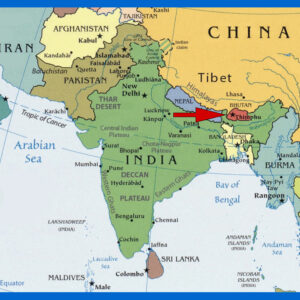
Eastern Himalayas. The tiny landlocked nation of
approximately 700,000 people is nestled in between two of
the world’s most populous countries – China to the north,
and India to the south. In spite of its geopolitical situation,
the country has thrived and grown from a largely agrarian based feudal society to a vibrant country on the rise in a short span of 50 years.
The country had largely been in a state of self-imposed isolation until the late 1960s with only a very select group of foreigners visiting the country then (those too were mostly professionals and volunteers that had been invited to Bhutan to help with the country’s development process).
In 1974, the country opened its
doors to tourists with the first group of travelers arriving from the United States of America. Since then, the tourism industry in Bhutan has steadily grown to become one of the major earners of foreign currency.
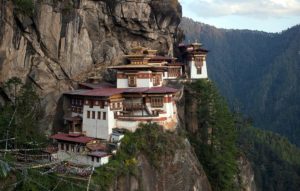 The Buddhist reverence for all living things and nature, coupled with the country’s exemplary conservation policies, has meant that Bhutan’s natural environment has flourished. Time and again, Bhutan has been recognized as one of the world’s most biologically diverse countries. The
The Buddhist reverence for all living things and nature, coupled with the country’s exemplary conservation policies, has meant that Bhutan’s natural environment has flourished. Time and again, Bhutan has been recognized as one of the world’s most biologically diverse countries. The
country is home to over 650 different bird species and at least 165 species of mammals. This is largely because of the country’s wide altitudinal
range (from below 200 meters/656 feet at its lowest to over 7,500 meters/24,500 feet at its highest) and its varied climate system. Besides
having an abundance of fauna, the country is also known for its rich variety in flora with over 6000 species of vascular plants, 600 species of orchids (of which 50 are endemic to Bhutan), 46 species of rhododendrons (4 endemic), and over 300 medicinal plants found within its boundaries. The constitution dictates that the country must maintain a forest cover of 60% (at the moment, approximately 72% of the country is under forest cover).
On this tour, we will immerse ourselves in a truly unique and intimate cultural experience. We will walk across open pastures, on ancient trails that used to connect different communities in days of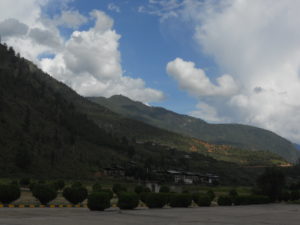
yore, visit mountaintop monasteries and villages, and mingle with the locals. Throughout the trip, the team at Montane Bhutan will attempt to give you an undiluted ‘Bhutanese’ experience unlike any other.
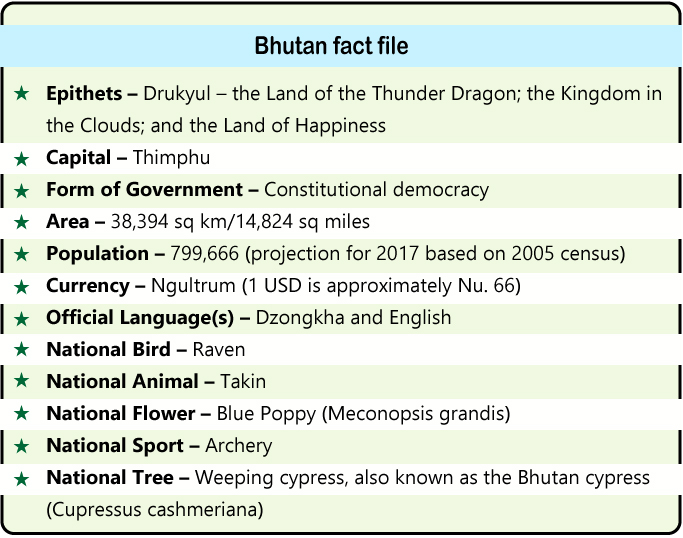
Day 1
Arrival in Bhutan, and drive to the capital – Thimphu Flying into Bhutan is quite a breathtaking experience. As you approach Paro International Airport, you will be treated to magnificent views of Western Bhutan’s mountain peaks – Jumolhari (7,320m/24,009ft), Jichu Drake (7,200m/23,616ft), and Tsheringma Gang (6,500m/21,320ft).
Paro International Airport is set in the valley of Paro (2,280m/7,478ft) – an idyllic and almost mystical valley at the edge of Western Bhutan. Upon touching down at the airport, you will immediately notice the transparent purity of the clean Himalayan air and an absence of noise. epresentatives of your local host – Montane Bhutan – will be waiting outside to receive you.
We will proceed to drive to the capital – Thimphu – once we have loaded up your luggage in the vehicle that will be at your service for the duration of the trip. The drive to Thimphu is a picturesque drive along the Pa-chhu (Paro river), and after the confluence with the Wang-chhu (Thimphu river), we will follow the Wang-chhu all the way to Thimphu.
The fast running rivers that flow through deep ravines are literally Bhutan’s white gold. Further down the confluence of the Thimphu and Paro rivers lies two of the Kingdoms’ biggest Hydropower Plants – the Chukha Hydropower Plant and the Tala Hydropower Plant. The export of
Hydropower to India is Bhutan’s major revenue generator.
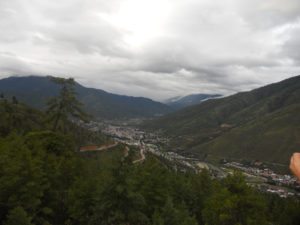 Thimphu is the center of government, religion and commerce and is a lively place, an interesting combination of tradition and modernity. Home to civil servants, expatriates and the monk body, Thimphu maintains a strong national character in its architectural style. Thimphu, perhaps is the only capital city in the world where traffic is regulated by a policeman instead of traffic lights.
Thimphu is the center of government, religion and commerce and is a lively place, an interesting combination of tradition and modernity. Home to civil servants, expatriates and the monk body, Thimphu maintains a strong national character in its architectural style. Thimphu, perhaps is the only capital city in the world where traffic is regulated by a policeman instead of traffic lights.
Upon arrival in Thimphu, we will drive up to the National Takin Reserve to get a glimpse of Bhutan’s national animal –
the takin. The takin is a rather strange looking creature that resembles a cross between a goat and a shaggy buffalo.
After stopping at the reserve for a while, we will end the day with a hike up to Wangditse Monastery. The hike is an hour’s walk up a hill that offers majestic views of Thimphu valley. We will hike on a comfortable trail that cuts through pristine forests of pine. This hike will help you in acclimatizing to the altitude and the thin Himalayan air.
Overnight: Thimphu (2,310 m/7,576 ft)
Day 2
Sightseeing in the Capital of Bhutan We will start the day by driving up to a quaint little village known as Dodena in North Thimphu. From the village, we will hike up to Tango Monastery. The relatively short hike (Will take approximately 40 minutes) will take you through pristene pine forests. In the 13th century, Gyalwa Lhanangpa – a Tibetan saint – had built a monastery on the spot where Tango monastery is presently located.
 In 1688, Gyalsey Tenzin Rabgye – the fourth temporal ruler of Bhutan – built Tango Monastery upon the same spot.The Monastery has stood there unchanged since then. Today, the Monastery houses a Buddhist College
In 1688, Gyalsey Tenzin Rabgye – the fourth temporal ruler of Bhutan – built Tango Monastery upon the same spot.The Monastery has stood there unchanged since then. Today, the Monastery houses a Buddhist College
where one can obtain a Master’s Degree in Buddhist Studies. The course typically takes 9 years to complete.
After hiking down from the Monastery, we will drive to town where we will visit the National Institute of Zorig Chusum. The institute is a
coeducational facility that trains youth in the traditional arts and crafts of Bhutan. After our visit to the Institute, we will drive to the Deysho Factory where we can see how deysho (traditional handmade paper) is produced.
We could also visit other places of interest before wrapping up our program for the day. These places include but are not limited to the Royal Textile Museum and the Weaving Center at Changzamtog.
Overnight – Thimphu (2,310 m/ 7,576 ft)
Day 3
Drive to the subtropical valley of Punakha
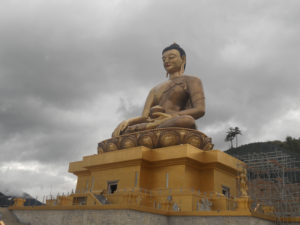 We will start the day with a visit to the National Memorial Chhorten.
We will start the day with a visit to the National Memorial Chhorten.
The Chhorten was built in 1974 in memory of the 3rd King – His Majesty
Jigme Dorji Wangchuck. A Chhorten, also known as a stupa in Sanskrit, is a mound-like or semi-hemispherical structure containing Buddhist relics, typically the ashes of Buddhist monks, used by Buddhists as a place of meditation. After spending about a half-an-hour or so at the Stupa, we will leave Thimphu for the subtropical valley of Punakha.
The distance between Punakha and Thimphu is 77 kilometers/48
miles and it usually takes about 2 hours to cover the distance. However,
we can expect our journey to take longer since we will be making
several stops along the way.
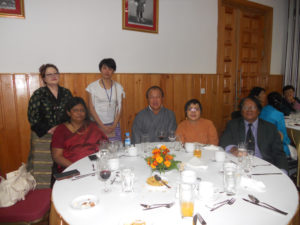 The drive will take us through Dochu La (‘La’means ‘pass’) (3050 m/ 10005 ft) where we will be making our first stop. If the skies are clear, we should be able to catch a breathtaking glimpse of the Eastern imalayan Range. From Dochula, we will descend through a winding road that goes through a temperate broadleaved forest of rhododendrens and magnolias. Soon, we will approach the sleepy town of Lobesa from where we will take a diversion that will lead us to the subtropical valley of Punakha. If time permits, we shall stop at Chimi Lhakhang (‘Lhakhang’ is the Dzongkha word for ‘Monastery’) along the way. Chimi Lhakhang was built in 1499 by Ngawang Choegyel, the then head of the Drukpa sect of Buddhism, but is most often associated with his cousin, Lam Drukpa Kuenley. According to legend, Drukpa Kuenley subdued a demon and trapped it in a rock where the monastery currently lays. Chime Lhakhang has also become famous as a fertility temple.
The drive will take us through Dochu La (‘La’means ‘pass’) (3050 m/ 10005 ft) where we will be making our first stop. If the skies are clear, we should be able to catch a breathtaking glimpse of the Eastern imalayan Range. From Dochula, we will descend through a winding road that goes through a temperate broadleaved forest of rhododendrens and magnolias. Soon, we will approach the sleepy town of Lobesa from where we will take a diversion that will lead us to the subtropical valley of Punakha. If time permits, we shall stop at Chimi Lhakhang (‘Lhakhang’ is the Dzongkha word for ‘Monastery’) along the way. Chimi Lhakhang was built in 1499 by Ngawang Choegyel, the then head of the Drukpa sect of Buddhism, but is most often associated with his cousin, Lam Drukpa Kuenley. According to legend, Drukpa Kuenley subdued a demon and trapped it in a rock where the monastery currently lays. Chime Lhakhang has also become famous as a fertility temple.
The Bhutanese firmly believe that visiting the Lhakhang will rid oneself of any infertility problems that one has, and it is very common for couples that are unable to conceive a child to visit the Lhakhang in hopes of curing any infertility problems that they might have.
Overnight –Punakha (1,350m / 4,428ft)
Day 4
Sightseeing in the valley of Punakha
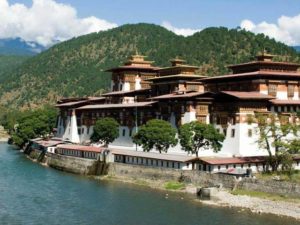 The river that cuts through the Punakha valley is called
The river that cuts through the Punakha valley is called
the Punatsangchhu, and it is formed by two glacially fed
tributaries – Pho Chhu and Mo Chhu (‘male and female
rivers’). Today, we will drive along the banks of the Pho
Chhu until we reach a long foot suspension bridge. The bridge is Bhutan’s longest suspension footbridge and one of the longest in Asia.
We will cross the bridge and walk towards the Punakha Dzong (‘Dzong’ is the Dzongkha word for ‘fortress). Originally known as Pungthang Dechhen Phodrang (The Palace of Great Bliss), Punakha Dzong was built in 1637 by Zhabdrung Ngawang Namgyal (Tibetan saint that unified Bhutan in the 17th century). It is without doubt one of the finer examples of Bhutanese architecture. Some of the most important moments in Bhutanese history have happened inside this Dzong. It was here that the first king of Bhutan, Ugyen Wangchuck, was crowned on 17th December, 1907. Since then, all the Kings of Bhutan have been enthroned in Punakha Dzong, and in 2011, the Royal Wedding of our King also took place in this Dzong. The Dzong also houses some of Bhutan’s most important religious relics such as the Rangjung Kharsapani, a small rice-sized statue with the image of Avalokiteshvara – the bodhisattva of compassion – on it. Later on, we will hike up to Khamsum Yuellay Namgyal Chhorten, a unique stupa built in 1999. Unlike other Bhutanese stupas which are made up of one solid block with no entrance, this sSupa houses a 3-Storied temple. The hike to the Stupa takes about 45 minutes. The Stupa offers magnificent views of the Punakha valley. After visiting the interior of the stupa, we shall continue hiking along the river which will take us through small villages set against the backdrop of golden rice fields.
Overnight –Punakha (1,350m / 4,428ft)
Day 5
Drive to Paro, and sightseeing
Today, we will backtrack all the way from Punakha to the mystical valley of Paro. Although we will be driving along the same road that we had driven on during our drive to Punakha, our drive will be just as fascinating as the first time around.
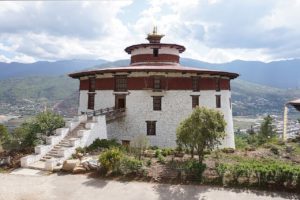 Along the way to Paro, we will stop at Tamchog Lhakhang. While the monastery itself is nothing out of the ordinary, the suspension bridge that connects to the monastery is very special. This suspension bridge is made out of chain links, and was built by a pioneer in civil engineering the great Tibetan saint and engineer Thangtong Gyalpo who lived in the early 15th century. Thangtong Gyalpo is believed to be the first to build a uspension bridge in the early 1400s atleast two centuries before the first suspension bridges would appear in the west. After a short stop at the monastery, we will continue on towards Paro.
Along the way to Paro, we will stop at Tamchog Lhakhang. While the monastery itself is nothing out of the ordinary, the suspension bridge that connects to the monastery is very special. This suspension bridge is made out of chain links, and was built by a pioneer in civil engineering the great Tibetan saint and engineer Thangtong Gyalpo who lived in the early 15th century. Thangtong Gyalpo is believed to be the first to build a uspension bridge in the early 1400s atleast two centuries before the first suspension bridges would appear in the west. After a short stop at the monastery, we will continue on towards Paro.
Upon reaching Paro, we will drive up to the Paro National Museum. The Museum houses the largest and most comprehensive collection of Bhutanese artifacts. The Museum used to be set in Paro Ta Dzong,
an ancient watchtower that overlooks the valley of Paro. However, an earthquake damaged the watchtower in 2011, and the exhibits in the museum were moved to a building near the watchtower. The watchtower is currently being renovated and is expected to be complete by December 2016.
From the Museum, we can embark on a short hike that will take us down to the magnificent Paro Dzong. We will then move on to Kyichu Lhakhang. Kyichu Lhakhang is the oldest monastery in Bhutan and is possibly the oldest extant structure in the country. It was built in the 7th century by Songsten Gampo – the first Buddhist king of Tibet.
If circumstances permit, we might also be able to watch an archery contest. Archery is the national sport of Bhutan, and the Bhutanese are very passionate about archery. Archery matches held in villages can be a very intense yet enjoyable experience, and the matches sometimes tend to bring in entire villages and communities for a communal and very festive gathering.
Overnight – Paro (2267 m/7478 ft)
Day 6
Excursion to Bhutan’s cultural icon – the Tiger’s Nest
No trip to Bhutan would be complete without a visit to Bhutan’s cultural icon – Taktsang (the ‘Tiger’s Nest’). Upon reaching the base of the cliff upon which the monastery complex is located, we will have to hike for about two hours to reach the monastery. The initial part of the hike is
through a forest of pine before the vegetation changes to massive oak trees. There is a cafeteria at the halfway point that offers an excellent view of the Tiger’s Nest.
 Taktsang is Bhutan’s most famous monastery and one of the most venerated pilgrimage sites in the Himalayan World. Perched on the side of a cliff at an altitude of 10,428 feet, Taktsang might be the finest example of Bhutanese architecture. The legend of Taktshang evolves from Tantric mythology. In 747 AD, the great tantric master Guru Rinpochhe (also known as Padma Sambhava) chose a cave on this sheer rock face to meditate in. However, the area was plagued by evil spirits and demons. The Guru assumed his wrathful form –Dorji Droloe – and rode astride a tigress that flew to Taktsang. He then proceeded to subdue the
Taktsang is Bhutan’s most famous monastery and one of the most venerated pilgrimage sites in the Himalayan World. Perched on the side of a cliff at an altitude of 10,428 feet, Taktsang might be the finest example of Bhutanese architecture. The legend of Taktshang evolves from Tantric mythology. In 747 AD, the great tantric master Guru Rinpochhe (also known as Padma Sambhava) chose a cave on this sheer rock face to meditate in. However, the area was plagued by evil spirits and demons. The Guru assumed his wrathful form –Dorji Droloe – and rode astride a tigress that flew to Taktsang. He then proceeded to subdue the
evil spirits that were haunting the region. It is also said that the spiritual consort of Guru emanated herself in the form of a tigress to safeguard the place during the Guru’s four month meditation retreat. Some people living in the valley saw the tigress lying by the cave and thought it to be a tiger’s lair thus the name ‘tak’ (tiger) ‘tshang’ (lair) came into existence and became one of the most popular pilgrimage sites in the Buddhist world.
A fire of unknown origin destroyed the main structure in 1998, however the monastery has since been rebuilt to its previous grandeur.
Overnight – Paro (2,267 m/7,478 ft)
Day 7
Departure from Bhutan
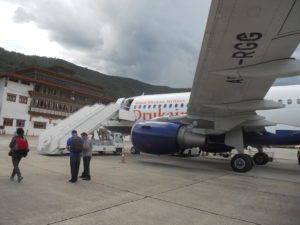 After breakfast, we will drive down to Paro International Airport to catch your departing flight
After breakfast, we will drive down to Paro International Airport to catch your departing flight
from Bhutan. Hopefully, you have had a very memorable time in the country and that this is the
beginning of what will be a lifelong connection to the Land of the Thunder Dragon. Safe travels and
Tashi Delek!!

Price quoted above is inclusive of the following:
• Hotel accommodation with all meals
• Ground Transportation with driver
• Licensed English-speaking tour guide
• Bhutan Visa fees and all other daily government fees
• Entry fees and permits to Parks, Museums, etc.
• Airfare and airport departure taxes in economy class
• Complimentary bottled water
• Daily sustainable tourism royalty of USD 65
The above prices maybe subject to change as per regulations of the Tourism Authority of Bhutan.

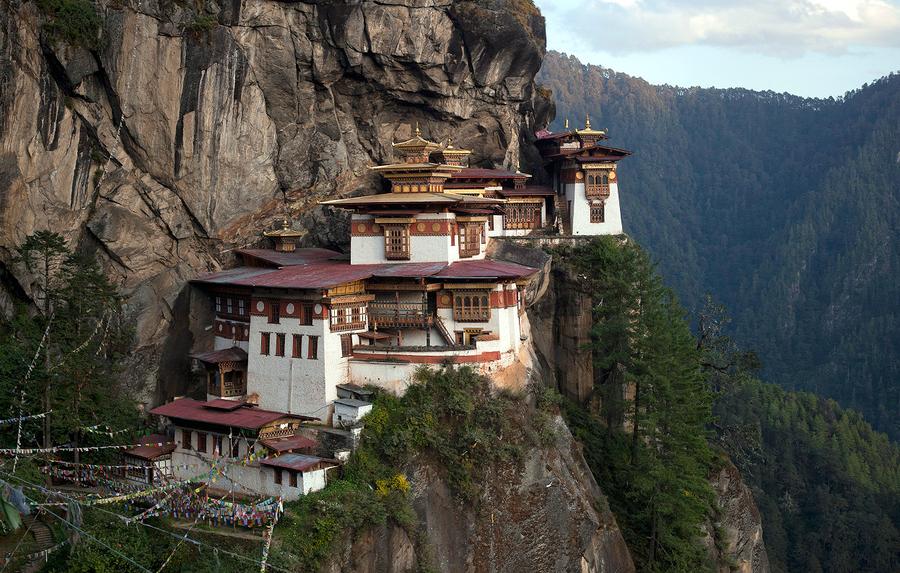


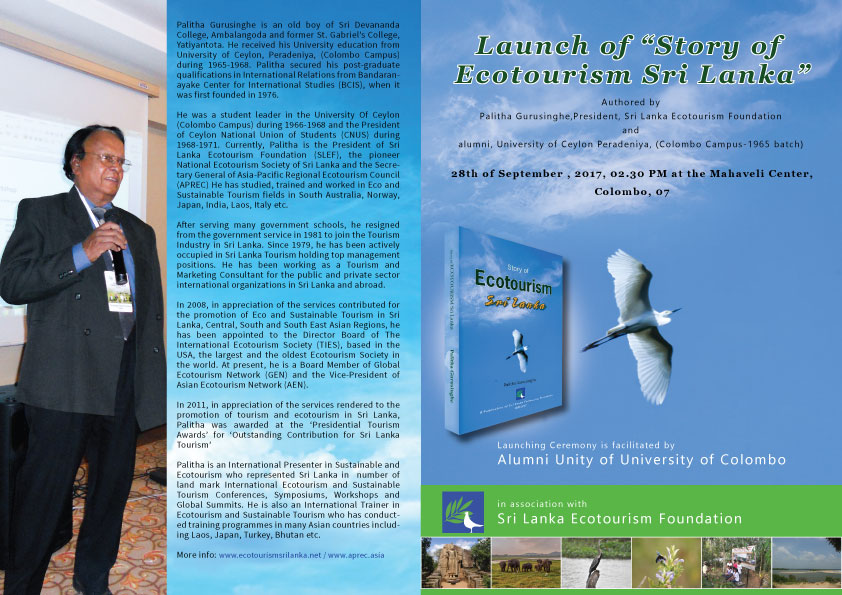
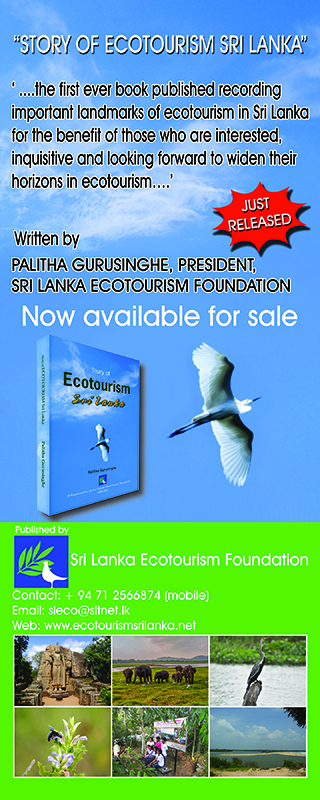 “Story of Ecotourism Sri Lanka” is written basically from the practical point of view, through the experience gained by the author over the years. Palitha, the founder President of Sri Lanka Ecotourism Foundation and the author of the book thought it is good to record important land marks of Sri Lanka Ecotourism for the benefit of those who are interested, inquisitive and looking forward to widen their horizons in Ecotourism.
“Story of Ecotourism Sri Lanka” is written basically from the practical point of view, through the experience gained by the author over the years. Palitha, the founder President of Sri Lanka Ecotourism Foundation and the author of the book thought it is good to record important land marks of Sri Lanka Ecotourism for the benefit of those who are interested, inquisitive and looking forward to widen their horizons in Ecotourism.